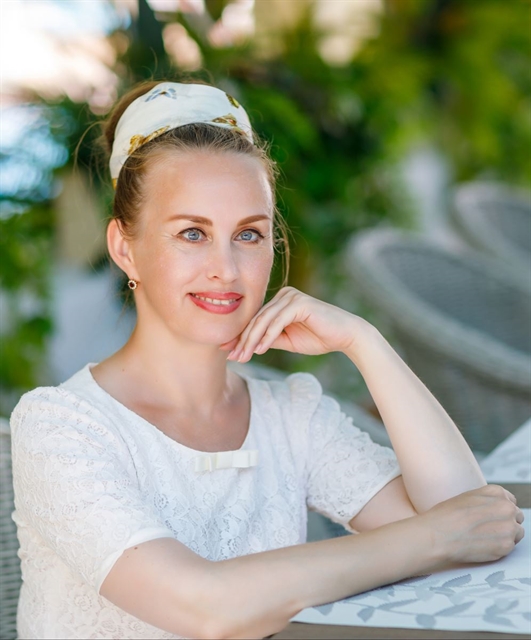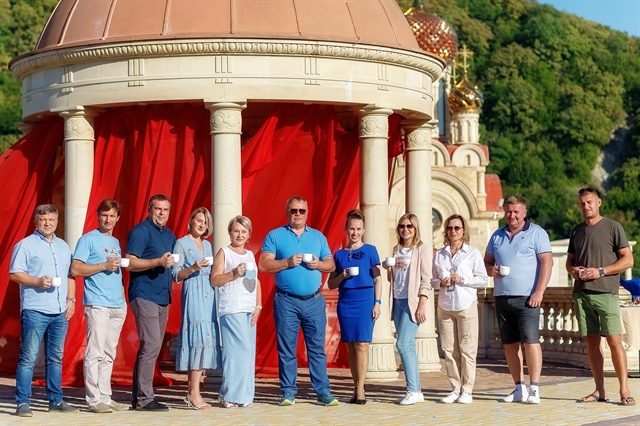
Vietnamologist Daria Mishukova. Photos courtesy of the scholar
Inner Sanctum: What initiated your two newly published books about Việt Nam?
The recent rules for social distancing, restrictions on local and international travel and recommendations to stay at home during the pandemic gave me plenty of time to read books and write books about Việt Nam.
I took this chance and used my time wisely. In my business routine in pre-COVID, I travelled a lot, up to 60 flights per year. When the international travel market and trade return to normal, I will have very little time for writing again.
This summer, I have not two but three new books about Vietnamese culture, the country and people. Vietnamese Fairy Tales Retold is the first one. The second is Vietnamese Cuisine: Delicious Stories. And last but not least, my favourite Việt Nam: Business with Dragon". All are in Russian.
These three books are available on the platform of the biggest Russian online bookstore, Litres. My first book, Việt Nam: The Land of Dragons and Fairies, was printed in Russian in 2007 and 2010, and in Vietnamese in 2013 and 2018.
Inner Sanctum: How did you go about it? Were there any difficulties in implementing your ideas?
I have always had a clear vision of what I want to share with the readers. When I was on my very first steps in Vietnamese studies and doing business in Việt Nam, I yearned for a truly informative book written in easy-to-read language, with lively, vivid examples and a contemporary cultural context of Việt Nam. I could not find one. So I wrote Việt Nam: The Land of Dragons and Fairies for the next generation.
But let us go back to folklore. Selected Vietnamese fairy tales were translated into Russian in 1950s and 1960s, but many were difficult to understand if readers knew little or nothing about specific aspects of Vietnamese culture. So I decided not to translate but to retell my favourite Vietnamese fairy tales to Russian readers, focusing on younger readers and adults who love oriental philosophy and wisdom.
Inner Sanctum: Could you tell me more about the book on Vietnamese legends?
I simply chose my favourite Vietnamese fairy tale and retold it in Russian as I remembered it. My selection of Vietnamese fairy tales for this book included: Lạc Long Quân and Âu Cơ (The tale of the Dragon and the Fairy), Sự tích trầu cau (The areca and betel tale), Sự tích quả dưa hấu (The tale of watermelon), Sự tích bánh chưng, bánh dày (The New Year’s cakes tale), and Sự tích chiếc nỏ thần (The Magical Bow tale).
Inner Sanctum: Are there any similarities or differences in the legends of Vietnamese and Russian people?
The great majority of Russian fairy tales begin with "Once upon a time" or "Far away and long ago".
Vietnamese fairy tales, on the contrary, are mostly quite specific about time and place. For example: During the reign of King Hùng VI or any of the 18 legendary kings of the Hùng dynasty.
Most European fairy tales end by telling the reader that the characters "lived happily ever after", while the Vietnamese tale of Lạc Long Quân and Âu Cơ has a romantic beginning with a beautiful family life with the birth of numerous children, but it terminates in separation and a specific amicable settlement.
It is probably it was the first official divorce in Vietnamese history. The legendary parents arranged split custody for their 100 children. Fifty followed their father to the sea, and the other half stayed with their mother in the highlands.
Foremost, I would like to mention the image of the dragon in Western and Eastern fairy tales and legends. The dragon has a bad reputation in Russian folklore and most European fairy tales and legends. Dragons are dangerous, greedy, and troublesome creatures. People who are living around and nearby suffer immensely from their tyranny.
The hero usually has to fight with a dragon, and only after killing this monster will he acquire a treasure of gold and diamonds or save a beautiful princess. A hoard from a dragon's cave appears in many legends (Siegfried, dragon Fafnir, and the famous hoard of the Nibelungs, etc).
Vietnamese folklore presents the dragon from a completely different, I would say almost opposite, perspective. For the Vietnamese, the dragon appears like a kind father, a wise teacher, and a powerful protector. People ask the dragon for support, help and protection.
The Vietnamese fairy tale Tấm Cám [about Tấm and her stepsister Cám], is a Vietnamese version of Cinderella, but more dramatic and with a touch of Oriental mysticism and a reincarnation theme.
Inner Sanctum: Reading these stories, what will Russian people understand about Vietnamese people and culture?
It is often that fairy tales are for reading in childhood. In my opinion, when a foreigner wants to understand the national mentality, core inner values, and way of thinking of a nation, folklore can reveal typical psychological patterns.
Usually, these categories change very little, not only from generation to generation but even on a large scale of hundreds and thousands of years. Deeply rooted inner impulses are with us subconsciously from times immemorial. Thanks to fairy tales, readers can know the soul of Vietnamese people and have a chance to decipher their cultural code. Understanding the national mentality and psychological patterns is very important for businesspeople in dealing with international partners.
Inner Sanctum: Could you tell me more about the book on Vietnamese cuisine?
Telling the story of Vietnamese food, I decided to start from the beginning. It is a very good place to start: from the philosophical meaning of the five basic elements (water, wood, fire, earth, metal) and five basic tastes (sweet, sour, salty, bitter, and spicy).
There is also the way of serving food in Vietnamese style, the art of using chopsticks, and some local superstitions, as well as how Vietnamese people regard what to eat in the morning, midday and evening. I grouped numerous Vietnamese dishes by category: appetisers, soups, sauces, main courses, and desserts.
Inner Sanctum: What are your own favourite Vietnamese dishes?
I love all kinds of tropical fruits. My favourite fruit is mango. My first and best choice for a smoothie is mango with passion fruit. Among hot dishes, I like Chả cá Lã Vọng -- grilled fish with fresh rice noodles. It is a delicious and iconic dish of Hà Nội, bright yellow pieces of grilled fish with green dill leaves and white noodles, very pleasant looking for the eyes and delicate to taste.

Daria (5th from right) and her colleagues at the iconic view of Albatros resort in Arhipo-Osipovka, southern Russia
Inner Sanctum: Tell me about your present work. How has your research on Việt Nam affected your life?
For many reasons, the current situation is still not favourable for international hospitality and tourism in Việt Nam. Business is very quiet, so my return to Việt Nam is being postponed until better times and the return of the international travel industry.
This summer, I do business development and management consulting for Albatros city, an excellent resort property in southern Russia, located in a quiet and picturesque place named Arhipo-Osipovka. It is a precious pearl of the Black Sea coastline and the first choice for many Russian families with children to spend their vacation. Arhipo-Osipovka very much resembles Mũi Né in Việt Nam in terms of location, situation and potential to develop.
Albatros city is the biggest and best family resort on this coastline. The owner and investor appreciated my experience in the Russian tourism industry in Việt Nam, so my research on Việt Nam directly affects my professional situation.
In the space museum in Arhipo Osipovka, I found a certificate of a flight into space from July 1980 signed by L. Popov, V. Rumin, V. Gorbatko and Phạm Tuân (the retired Việt Nam Air Force aviator and cosmonaut) and a small red flag with a golden star of Việt Nam, also signed by Phạm Tuân. VNS
OVietnam